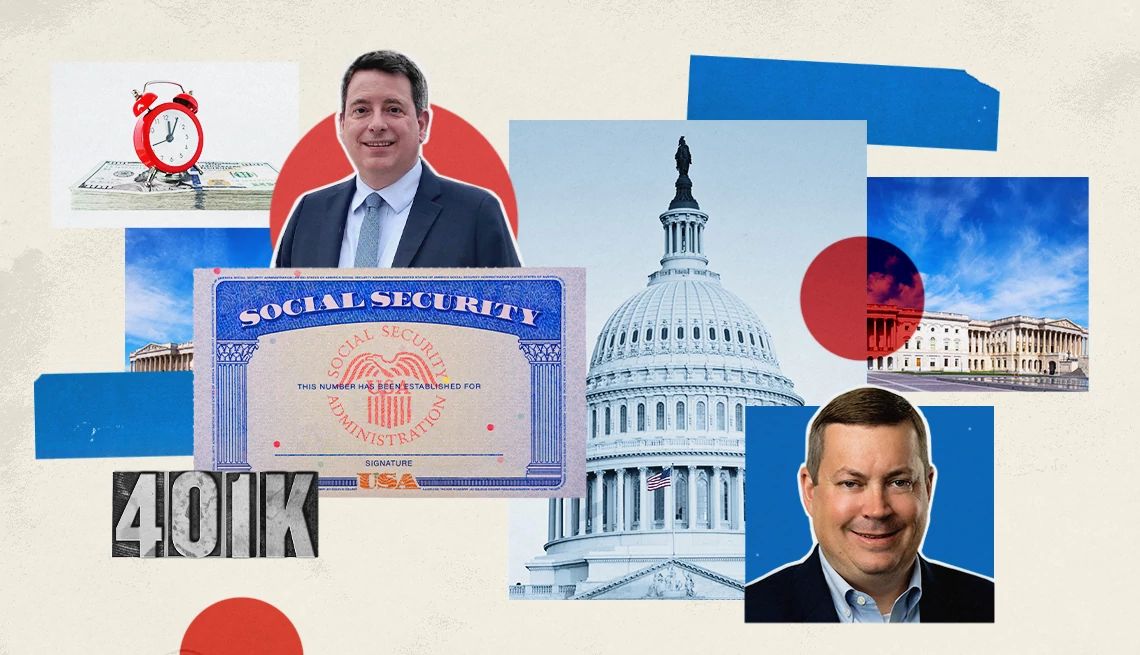AARP Hearing Center


Retirement is supposed to be a time for pursuing passions and pleasures after a long career. But this rite of passage is looking more stressful than sweet for many Americans. Sixty-four percent of adults ages 30-plus worry about having enough money in retirement, according to AARP research. And roughly 1 in 5 of those adults report having no retirement savings whatsoever.
AARP has spent the summer spearheading celebrations for Social Security’s 90th anniversary and calling on Congress to protect this bedrock of American retirement. While the program is an essential part of a secure retirement, it shouldn’t be the sole source of income American retirees rely on to fund their later years, two of AARP’s top lobbyists say.
We sat down with Bill Sweeney, AARP’s senior vice president for government affairs, and Chad Mullen, AARP’s government affairs director for financial security, to discuss what’s needed today for a financially secure retirement, why so many Americans are struggling to meet those needs, and how AARP is working toward fixes.
This month, Social Security turned 90. AARP put a lot of effort into spotlighting and celebrating the anniversary throughout the summer. Why?
Bill Sweeney: AARP was founded because Ethel Andrus came across a colleague, a former teacher, living in a chicken coop in retirement because she couldn’t afford to make ends meet. We were created, and we still exist today, to try and make sure that never happens again. And Social Security is, without a doubt, the most important way we keep older Americans out of poverty, making sure they have a little bit of money coming in every month.
Social Security is a powerful story of success in America, and it has really become the foundation of American retirement. But because it’s been around for 90 years, it’s never missed a paycheck, and it generally runs pretty well, members of Congress kind of take it for granted. So it is really important for us to use every opportunity we can to remind Congress about how critical it is to their constituents and that they need to work to protect it.
What exactly needs protecting?
Sweeney: I’d say there are two big things that need Congress’ attention right now. The first one, which is the most foundational, is that they need to get focused on addressing the solvency of Social Security. [The year] 2034 may feel like a lifetime away for Congress, but we know our members are deeply concerned with that date, which is when the trust funds are currently predicted to run short. I do believe that no member of Congress in their right mind would ever go home to their constituents having let Social Security benefits get cut by 20 percent, so I feel pretty confident that they will address this.
The last time Congress dealt with this was in 1983, and they didn’t pass solutions until about three months before the insolvency date. But we want to make sure they’re focused on it. Almost no one in Congress right now has ever gone through a solvency fight before. They need to understand what’s at stake and what the options are.
The other big issue that we’re raising is the customer service crisis at Social Security. It’s just way too hard to get the answers and help you need from the Social Security Administration, and this has been going on for a long time, in large part because Congress has been steadily defunding the agency as the number of people claiming Social Security has gone up and up. We're at record numbers of people turning 67 and wanting to retire and claim their benefits, but the funding for the Social Security Administration as a percentage has gone down. And it’s just simple economics that more demand and less supply equals bad customer service. So we are urging them to make sure there is adequate funding for the agency to do better.
Amid demands to address Social Security’s solvency, debate around privatizing the program reemerged. AARP publicly condemned a comment made by U.S. Treasury Secretary Scott Bessent suggesting a "backdoor" method for privatizing Social Security. Explain why AARP opposes the privatization of Social Security.
Sweeney: The idea of taking money out of Social Security and putting it into private accounts is not a good one. AARP has been clear about that for a long time. There was an attempt to do that in 2005, and we resoundingly defeated that attempt. And it’s a good thing we did, because three years later the stock market crashed, and if you had put your Social Security in a private account and it was time for you to retire, you would have had no money to do so.



































































More From AARP
Social Security Goes Up in Lights
AARP takes over Times Square to celebrate 90 years of an American hero
OAA Turns 60: What’s in It for You?
The 1965 law built a network of local support for older adults across the U.S.
An Inside Look at How AARP Is Fighting for You
AARP flooded Washington, but our efforts go far beyond the halls of Congress